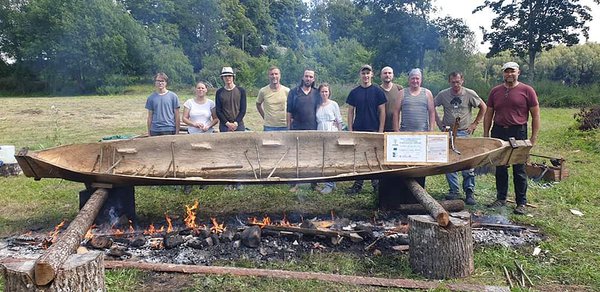On March 19, Estonia's minister of culture Tõnis Lukas signed the application to nominate "Building and use of expanded dugout boat in Soomaa region" to UNESCO list of intangible cultural heritage in need of urgent safeguarding. The decision on inscribing dugout boat culture of Soomaa into the global list will be made by UNESCO at the end of 2021.
The dugout boat of Soomaa represents an indigenous Estonian and Finno-Ugric cultural heritage which is embodied in the traditional building techniques of the dugout boat, as well as its various uses, including as everyday vehicle during annual floodings. Today, Soomaa is the western border of the usage area of the dugout boat in Eurasia.
Even though currently the dugout boat culture of Soomaa is rather viable due to five dugout boat masters and supportive Soomaa local community, longer-term survival of Soomaa's dugout boat culture requires further efforts and safeguarding. For this reason, Estonian Dugout Boat Society NGO led the preparation of the nomination to UNESCO.
In the words of Aivar Ruukel, leader of the "Dugout Boat to UNESCO" project and a dugout boat master, the main objective of the UNESCO application is to ensure succession of masters: "Our greatest hope is to awaken interest in the building of dugout boats among young men, but why not also among young women. If after 20 years we have some young and energetic dugout boat masters, then we have reached our goal."
UNESCO application was prepared in close consultations with the local community of Soomaa. Sandra Urvak, active member of the Soomaa community, says that making it to the UNESCO list would help residents of Soomaa appreciate their ancient cultural heritage even more, "For the people of Soomaa, for whom the dugout boat is something natural, the drawing of such International attention has brought much enthusiasm, strengthened their self-confidence and interest in their cultural heritage in a wider sense, also beyond the dugout boat."
The application to UNESCO includes a detailed safeguarding plan for 2020-2023. Its main author, Priit-Kalev Parts, leader of the Estonian Native Construction Society NGO and a dugout boat master, says that the dugout boat of Soomaa represents an archaic vessel type which is also a high achievement of humanity's woodworking technology, "UNESCO nomination would draw the attention the general public and future generations to the value and vulnerability of the dugout boat culture".
Nomination of Soomaa's dugout boat culture to UNESCO has also a wider Finno-Ugric and indigenous dimension. According to Oliver Loode (URALIC Centre for Indigenous Peoples NGO) Soomaa's application motivates indigenous peoples worldwide to set their thoughts on UNESCO, "Unfortunately the UNESCO Convention for the Safeguarding of the Intangible Cultural Heritage is still unknown among many indigenous peoples. Soomaa's nomination allows to increase awareness of the UNESCO convention also in states where the UNESCO convention has not yet been ratified, including in Russia, Canada, USA, Australia and New Zealand – i.e., states with extremely rich indigenous intangible cultural heritage."
Leelo Viita, head of the intangible cultural heritage centre at the Estonian Folk Culture Centre highlighted that Soomaa's nomination is the first one from Estonia for the list of intangible cultural heritage in need of urgent safeguarding – previous nominations have been to the representative list.
According to Margit Siim, coordinator of cultural programmes at the Estonian National Commission of UNESCO, the nomination has good chances to make it to the UNESCO list, because it has been designed at the initiative of dugout boat masters and the local community, and has been rigorously thought through. The process of developing the application has activated the community further, and has helped raise awareness of the dugout boat culture in Estonia.
As part of the development of the nomination, a public competition of dugout boat photos was conducted, as a result of which 10 representative photos were selected (bit.ly/UNESCO-haabjas-fotod ) and a short film was prepared by the Estonian National Museum about the building and use of dugout boats ( bit.ly/UNESCO-haabjas-video ). Those interested to learn more about the dugout boat culture of Soomaa are encouraged to visit the dugout boat portal haabjas.com .

Write first comment